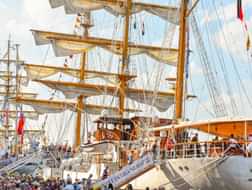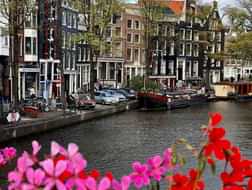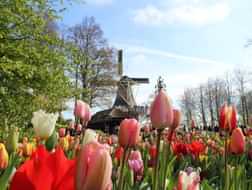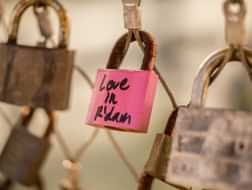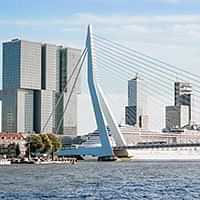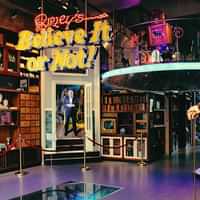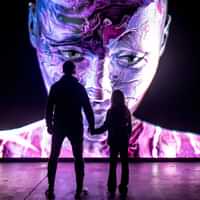Not to miss sights of Germany’s Modern History

Every year, Germany celebrates its reunification on October 3rd, the so called ‘Tag der Deutschen Einheit’, to commemorate when the Federal Republic of Germany was once again united with the former German Democratic Republic, the GDR. Not only did the Cold War end but also the Berlin Wall, once separating the two countries, fell.
The public holiday is celebrated with ceremonies and festivals as well as multiple exhibitions every year. Hence, October is the ideal time to visit Berlin and get a detailed glimpse into Germany’s recent history that is still very prevalent and influential on the country to this day.
Take part in the celebrations
At the beginning of October, you’ll find Berlin’s event calendar filled with ceremonies, services, ceremonies and performances over the course of 3 days celebrating the annual German Unity Day with a so called ‘Bürgerfest’. The festivities are enriched by a diverse program of music, comedy and poetry slams. The festival takes place at the Brandenburg Gate where three main stages are usually set up.
Newcomers as well as world renowned artists and actors will present themselves at the local festival. The musical program is just as diverse, ranging from classical music to street music. The festival is further accompanied other independent festivities at the same time.
For example, you can listen to a classical concert at the State Chapel or join Berlin’s choirs and sing along with them in the Nikolaikirche. From exhibitions to concerts, cabaret to the ‘Day of Club Culture’ – Berlin’s a conglomeration of culture, history, remembrance and music on October 3rd.

Berlin Wall Memorial
The Berlin Wall memorial is one of the key memorial sites of the German separation and its countless victims. This open-air exhibition extends over 1,4 kilometres and reveals the remains of the Berlin Wall, showing the last pieces of the former Death Strip with the preserved areas behind it. It gives a fascinating insight into how the Berlin Wall was set up and how it affected the lives on both sides of the Wall. The Memorial additionally organizes panels, additional exhibitions, publications and workshops.
Four different sites are part of the exhibition: the Window of Remembrance, Monument in Memory of the Divided City Chapel of Reconciliation and the excavated foundations of a former apartment building whose façade functioned as the border wall until the early 80s as well as the Victims of Communist Tyranny.
The world’s longest open-air art exhibition
The famous East Side Gallery is the world’s longest open-air exhibition as well the longest piece of the Berlin Wall that was preserved. After the fall of the Berlin Wall, this 1,3 kilometre long piece located on the Northern side of the Spree was painted with designs by 118 artists from 21 countries.
The colourful and message-loaded paintings include the famous portrait of the ‘Brother’s Kiss between Honecker and Breschnew, painted by Russian artist Dmitri Wrubel. Nowadays, the East Side Gallery is both a symbol of joy over the German reunification as well as a historical reminder of the oppressiveness of the GDR government.

Die Mauer Yadegar Asisi Panorama
Ever wondered how standing in the middle of East Berlin might’ve felt? Experience it through this fascinating 360° panorama exhibition at the Asisi panorama near Checkpoint Charlie. This unique exhibition was brought to life by artists Yadegar Asisi. The artist takes you on a journey through life in the shadow of the former Death Strip.
Experience this realistic glimpse into this seemingly absurd reality on a life-sized scale. Wander around houses occupied by artists, punks and tourists as well as border guards right next to the Death Strip, see the Wall from the perspective of a Kreuzberg resident from the Western side and take a look at the artist’s private photo collection of the night the Wall fell.
BlackBox Cold War
This unique multimedia exhibition gives a glimpse into the confrontations between the blocs that lasted from 1945 to 1990. It intends to act as a flight recorder through 16 stations full of videos, fascinating exhibits and photos and give an insight into the tumultuous era of the Cold War and the divide of Germany.
The exhibition is located in a box-shaped, black building close by to Checkpoint Charlie that definitely catches the eye. Here, you can learn more about Germany’s very recent history through original historical film clips, testimonials from witnesses and rare exhibits, for example radiation dosimeters or the model of a Soviet T-62 tank.
Experience day-to-day life under the GDR
The DDR museum offers a detailed look into everyday life under the former regime of the GDR through interactive exhibitions. The museum is the largest, most interactive and diverse exhibition focusing on life under the GDR in Berlin, consisting of 47 themed areas spread across 1000 m2. Here, you can explore day-to-day life in the GDR through a reconstructed apartment from East Berlin.
Learn all about life under the communist regime, sit down in an original theatre to watch local news and dance to the East German answer to rock’n’roll. This exceptional and inclusive visitor experience makes the DDR museum not only one of the most popular museums in the city but it also engages all the senses of its visitors.
Berlin’s most famous checkpoint
Checkpoint Charlie is one of the most famous attractions in all of Berlin. The former checkpoint at the border between the US and Soviet sector was a busy crossing point between West and East Berlin. The scenery of the Checkpoint hasn’t changed much since then – the checkpoint booth as well as the surrounding sandbags and the barrier are still in their place.
Today, the former checkpoint commemorates the countless clashes between the allies and those who tried to flee the GDR and either accomplished their goal or failed. It is also one of the most famous sites of the Cold War still in existence and a symbol of both division and union.
Not far from here lies the Mauermuseum – Museum Haus am Checkpoint Charlie. that gives a close up glimpse into the chronology of events that took place close by to the checkpoint and the experiences of GDR citizens who fled, often with spectacular hiding places and escape routes. The Mauermuseum was created by resistance fighter Dr. Rainer Hildebrandt right after the Wall fell and has not only documented its impact ever since but also documented and supported planned escapes.
Our top tips
